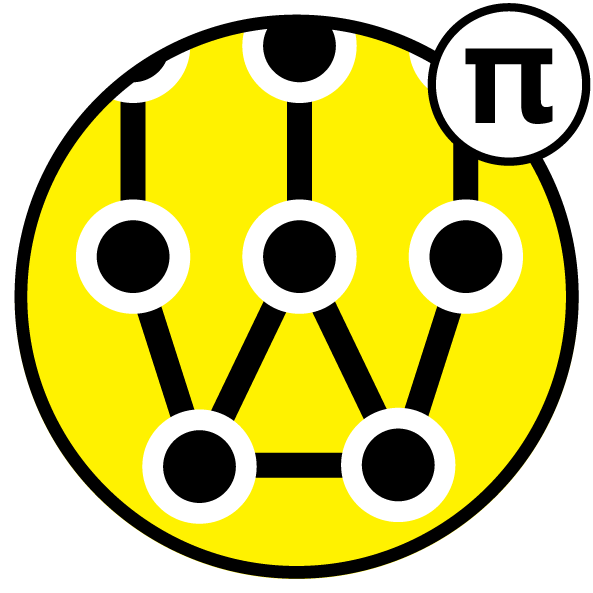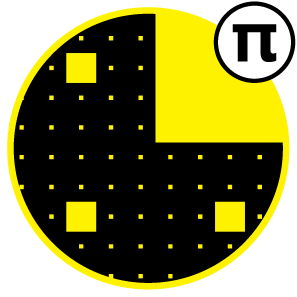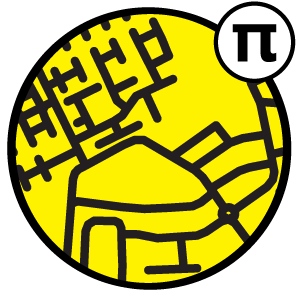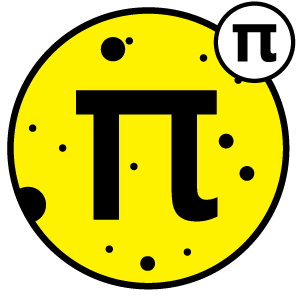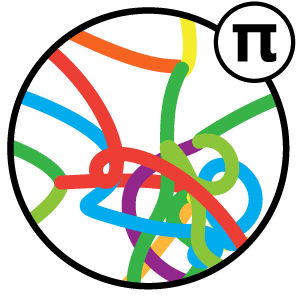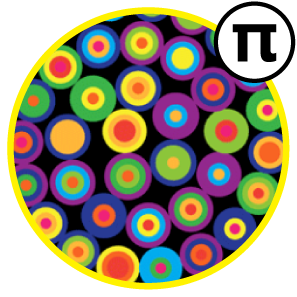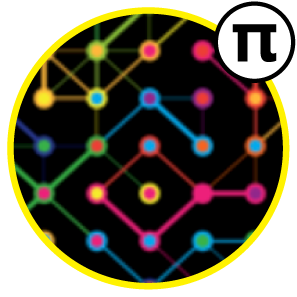Pi Day 2023 — Repeated Sequence — A modular synthesizer experience
On March 14th celebrate `\pi` Day. Hug `\pi`—find a way to do it.
For those who favour `\tau=2\pi` will have to postpone celebrations until July 26th. That's what you get for thinking that `\pi` is wrong. I sympathize with this position and have `\tau` day art too!
If you're not into details, you may opt to party on July 22nd, which is `\pi` approximation day (`\pi` ≈ 22/7). It's 20% more accurate that the official `\pi` day!
Finally, if you believe that `\pi = 3`, you should read why `\pi` is not equal to 3.
People find these numbers inconceivable — and I do too. Best thing to do is just relax and enjoy it. —Richard Feynman
Welcome to 2023 Pi Day: a celebration of `\pi` and mathematics, electronic music and cables. A lot of cables.



contents
This piece was created with a modular synthesizer system, which you can see in the video. Look for the closeups to meet some of the key modules in the patch, such as Vector Space and the Triple Sloths.
You've probably seen at least one synthesizer — most have a keyboard, which allow you to select a note, and they all have a bunch of knobs, which allow you to shape the sound giving you wide control over what a note will sound like. This latter process is broadly known as sound design.
If you were to open up such a synthesizer, you'd see a bunch of different circuits hooked up to the knobs, with each circuit having a specific role in the signal flow. This is a simplification, but it's good enough.
In a modular synthesizer, those individual circuits are broken up into modules that you purchase separately. Each module has its own function — everything from making a sound to filtering to mixing and more. It's probably best to call such a setup a modular system since it can veritably act as multiple synthesizers, each composed of a group of modules.
The modules themselves come in a wide variety of designs and sizes. Some modules are very narrow and some are very wide, though the height of the module is fixed within a given modular standards. For example, Eurorack modules are 5.25" in height (3U, 1U = 1.75") whereas the Buchla/Serge system uses 4U (7") and Moog modular synth modules are 8.75" tall. There are even some short 1.75" (1U) modules in the Eurorack world.
The Triple Sloth is chaos circuit module. It output is the solution to a system of differential equations, similar to the Lorentz System.
There are three sloths, called Torpor, Inertia and Apathy. These have periods of about 20 seconds (Torpor), 2 minutes (Apathy) and 20 minutes (Inertia). You can see the realtime output of the Inertia slot at this point in the video.
There's also a much slower sloth — Sloth DX — with a 20 hour period. This Sloth DX has capacitors that are so large that they stick out from the front of the module. As far as I know, this is the only module that exposes is internal components in this way.
This is a much longer version of the original 1 hour Repeated Sequence, which only went to the Feynman Point (769 digits).
In the 10 hour version we go to 10,000 digits. Up to the Feynman Point, this longer version is identical to the 1 hour version. After this point, though, it just keeps going — we let the modular patch play itself. During this time, we switch reels on the Morphagene to Esther and Anja giggling. There's mumbling too.
Starting at 8,000 digits, we ramp up the rack to a finale at 10,000 digits and then ramp down the rack for an outro. The last ~1,500 digits are read out at 4 digits per second in about 6 min 15 seconds.
If you'd like to learn the basics of modular synthesis, check out the Methods section.

Nasa to send our human genome discs to the Moon
We'd like to say a ‘cosmic hello’: mathematics, culture, palaeontology, art and science, and ... human genomes.



Comparing classifier performance with baselines
All animals are equal, but some animals are more equal than others. —George Orwell
This month, we will illustrate the importance of establishing a baseline performance level.
Baselines are typically generated independently for each dataset using very simple models. Their role is to set the minimum level of acceptable performance and help with comparing relative improvements in performance of other models.

Unfortunately, baselines are often overlooked and, in the presence of a class imbalance5, must be established with care.
Megahed, F.M, Chen, Y-J., Jones-Farmer, A., Rigdon, S.E., Krzywinski, M. & Altman, N. (2024) Points of significance: Comparing classifier performance with baselines. Nat. Methods 20.
Happy 2024 π Day—
sunflowers ho!
Celebrate π Day (March 14th) and dig into the digit garden. Let's grow something.

How Analyzing Cosmic Nothing Might Explain Everything
Huge empty areas of the universe called voids could help solve the greatest mysteries in the cosmos.
My graphic accompanying How Analyzing Cosmic Nothing Might Explain Everything in the January 2024 issue of Scientific American depicts the entire Universe in a two-page spread — full of nothing.
The graphic uses the latest data from SDSS 12 and is an update to my Superclusters and Voids poster.
Michael Lemonick (editor) explains on the graphic:
“Regions of relatively empty space called cosmic voids are everywhere in the universe, and scientists believe studying their size, shape and spread across the cosmos could help them understand dark matter, dark energy and other big mysteries.
To use voids in this way, astronomers must map these regions in detail—a project that is just beginning.
Shown here are voids discovered by the Sloan Digital Sky Survey (SDSS), along with a selection of 16 previously named voids. Scientists expect voids to be evenly distributed throughout space—the lack of voids in some regions on the globe simply reflects SDSS’s sky coverage.”
voids
Sofia Contarini, Alice Pisani, Nico Hamaus, Federico Marulli Lauro Moscardini & Marco Baldi (2023) Cosmological Constraints from the BOSS DR12 Void Size Function Astrophysical Journal 953:46.
Nico Hamaus, Alice Pisani, Jin-Ah Choi, Guilhem Lavaux, Benjamin D. Wandelt & Jochen Weller (2020) Journal of Cosmology and Astroparticle Physics 2020:023.
Sloan Digital Sky Survey Data Release 12
Alan MacRobert (Sky & Telescope), Paulina Rowicka/Martin Krzywinski (revisions & Microscopium)
Hoffleit & Warren Jr. (1991) The Bright Star Catalog, 5th Revised Edition (Preliminary Version).
H0 = 67.4 km/(Mpc·s), Ωm = 0.315, Ωv = 0.685. Planck collaboration Planck 2018 results. VI. Cosmological parameters (2018).
constellation figures
stars
cosmology
Error in predictor variables
It is the mark of an educated mind to rest satisfied with the degree of precision that the nature of the subject admits and not to seek exactness where only an approximation is possible. —Aristotle
In regression, the predictors are (typically) assumed to have known values that are measured without error.
Practically, however, predictors are often measured with error. This has a profound (but predictable) effect on the estimates of relationships among variables – the so-called “error in variables” problem.

Error in measuring the predictors is often ignored. In this column, we discuss when ignoring this error is harmless and when it can lead to large bias that can leads us to miss important effects.
Altman, N. & Krzywinski, M. (2024) Points of significance: Error in predictor variables. Nat. Methods 20.
Background reading
Altman, N. & Krzywinski, M. (2015) Points of significance: Simple linear regression. Nat. Methods 12:999–1000.
Lever, J., Krzywinski, M. & Altman, N. (2016) Points of significance: Logistic regression. Nat. Methods 13:541–542 (2016).
Das, K., Krzywinski, M. & Altman, N. (2019) Points of significance: Quantile regression. Nat. Methods 16:451–452.
Convolutional neural networks
Nature uses only the longest threads to weave her patterns, so that each small piece of her fabric reveals the organization of the entire tapestry. – Richard Feynman
Following up on our Neural network primer column, this month we explore a different kind of network architecture: a convolutional network.
The convolutional network replaces the hidden layer of a fully connected network (FCN) with one or more filters (a kind of neuron that looks at the input within a narrow window).

Even through convolutional networks have far fewer neurons that an FCN, they can perform substantially better for certain kinds of problems, such as sequence motif detection.
Derry, A., Krzywinski, M & Altman, N. (2023) Points of significance: Convolutional neural networks. Nature Methods 20:1269–1270.
Background reading
Derry, A., Krzywinski, M. & Altman, N. (2023) Points of significance: Neural network primer. Nature Methods 20:165–167.
Lever, J., Krzywinski, M. & Altman, N. (2016) Points of significance: Logistic regression. Nature Methods 13:541–542.





